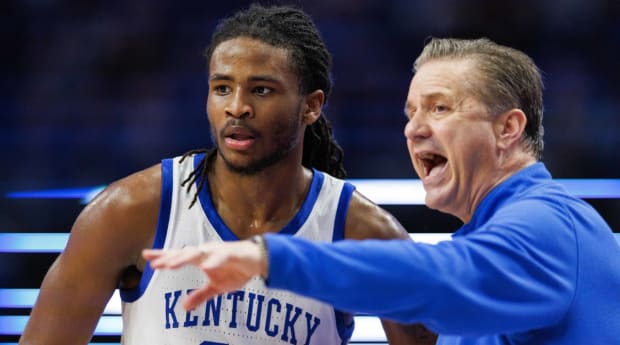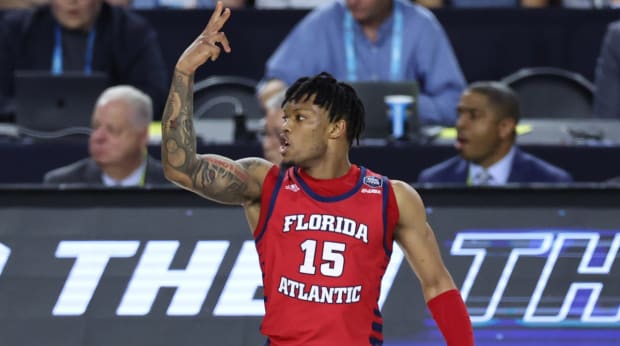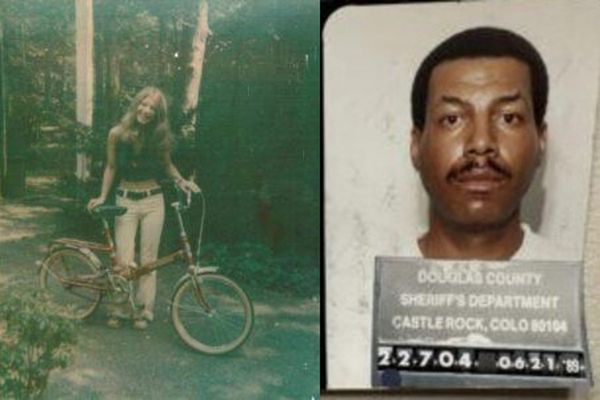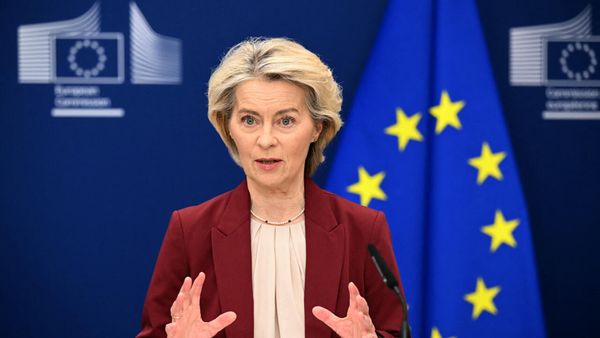With spring now the busiest time of the year for roster shaping in men’s college basketball, let’s take a look at the sport’s 10 most compelling offseason story lines as programs shift their focus to 2023–24.
1. Kentucky’s player churn as John Calipari enters crucial credibility season
Since giving Calipari a so-called “lifetime” contract worth $86 million in 2019, Kentucky’s return on that massive investment has been a pittance. The Wildcats have a 2–5 postseason record (1–3 in the SEC tournament, 1–2 in the NCAA tourney) and authored one of the worst seasons in school history (9–16 in ’21). The contract handcuffs the school to a coach who hasn’t advanced to the NCAA Sweet 16 since ’19, hasn’t been to the Final Four since ’15 and hasn’t beaten a higher-seeded team in the Big Dance since ’14.
The dwindling contingent of Cal backers is holding out understandably high hopes for the upcoming season. The Cats are bringing in the No. 1 recruiting class in the nation, with four players who are consensus national top-10 freshmen and will expect to start right away. But a big question hovers over this team: Which veterans will fill out the lineup and provide leadership? In a sport where teams built on one-and-done freshmen tend not to win championships, a balanced roster is crucial.
Thus Kentucky fans are anxiously awaiting the NBA decisions of big man Oscar Tshiebwe (team highs of 16.5 points and 13.7 rebounds), wing Chris Livingston (6.3 points, 4.2 rebounds) and shooting guard Antonio Reeves (14.4 points). That will impact Calipari’s activity in the transfer portal, where Kentucky has been laying low so far this spring. Defensive post presence is an acute concern: The Wildcats were lacking there last year, but got a boost this week when 7-foot Ugonna Onyenso pulled his name out of the transfer portal after a freshman season of paltry playing time.

Jordan Prather/USA TODAY Sports
Calipari has rarely gotten the most out of his talent at Kentucky—if he had, the Cats would have won two or three more national championships during his tenure. Amid complaints about style of play, in-game coaching and roster construction, Cal needs to maximize this team’s considerable talent to justify his bloated contract.
2. Purdue’s self-examination
No top-level program has had a more ghastly three-year run in the NCAA tournament than the Boilermakers, who have been eliminated in succession by a No. 13 seed (North Texas), a No. 15 (Saint Peter’s) and a No. 16 (Fairleigh Dickinson, quite possibly the worst team to ever win a tourney game). The FDU debacle banished 2023 Purdue to a level of March Madness infamy previously occupied only by ’18 Virginia.
Matt Painter knows how to win games in preconference play, the Big Ten and the league tournament—but he’s got to take a hard look at his program this offseason to end this cycle of March meltdowns.
Painter recently told The Athletic his teams have been vulnerable against short, athletic guards in the tournament. “I didn’t concentrate on having enough athleticism and quickness,” he said. That could be construed as damning commentary on the guard play in the Big Ten, since that weakness wasn’t much exposed as the Boilers went 42–17 in the league the past three seasons. It also overlooks the fact that Painter had one of the most athletic guards in recent years in Jaden Ivey, who was the No. 5 pick in the 2022 NBA draft.
The suspicion here is Purdue’s biggest problem is not how fast the players can move their feet but how much they can slow down panicked minds at tournament time. In all three recent massive upsets, the Boilers looked burdened by pressure—tentative, unsure and incapable of exploiting their obvious advantages.
Evidence: Purdue has been one of the top offensive efficiency teams in the nation in recent years, until tournament time. Against FDU, the Boilers’ 58 points were their fewest in a month; the 64 against Saint Peter’s was their fewest in five weeks; the 61 in regulation against North Texas was their fewest in more than six weeks. A prolific offensive machine keeps breaking down at the worst times—missing shots, committing turnovers, failing to quickly take command against inferior opponents.
If National Player of the Year Zach Edey returns for another season, Purdue will again be highly ranked and win a lot of games. But the Boilers will have a lot to prove next March, no matter how good they are before then.
3. The Big East gets even better
Connecticut gave America’s most prominent basketball-first conference its third national title in the past seven NCAA tourneys, taking the baton in a post–Jay Wright league and running with it. That capped off a Big Dance in which the Big East landed three teams in the Sweet 16 and two in the Elite Eight. And now the conference is poised for bigger things to come.
Almost all way-too-early top 25 projections have both UConn and Marquette in the top five, and some of them have one or the other No. 1. Creighton was jarred by the transfer of point guard Ryan Nembhard, but got a boost with the announced return of wing Baylor Scheierman (others, including center Ryan Kalkbrenner, haven’t yet declared their intentions). Xavier will remain competitive in Year 2 under Sean Miller.
Meanwhile. the rest of the league should be getting better behind them.
The Big East had two of the biggest coaching hires in the nation: St. John’s will instantly improve under Rick Pitino, and Georgetown will do the same under Ed Cooley. Losing Cooley could hurt Providence, but new coach Kim English has done quick work to retain key players there. Kyle Neptune and Shaheen Holloway also should make strides in their second seasons at Villanova and Seton Hall, respectively.
4. Hubert Davis’s old-new alchemy heading into a critical season
To date, Davis’s tenure as the successor to three-time national champion Roy Williams at North Carolina has been 13 games of boom and 59 of bust. His 11–2 run from Feb. 19 to April 4, 2022, featured some incredible highs—most notably upsetting Duke in Mike Krzyzewski’s final home game, eliminating reigning NCAA champion Baylor, and then ending Coach K’s career in a Final Four classic. But before and after that his Tar Heels have gone 38–21, with the profile of an NIT program instead of a national powerhouse.
Davis’s attempt to prove he has staying power is built on two familiar pillars in big man Armando Bacot (132 games played at UNC) and point guard RJ Davis (101 games). Everything else is going to be new. The portal turnstile is turning both ways, with the Tar Heels still in pursuit of a couple of instant-impact transfers and perhaps poised to benefit from the departure of volume-shooting Caleb Love to Michigan. (Love’s career shooting percentages of 39.7 percent from two-point range and 31.7 from three are not ideal for someone who launched 1,360 shots in three seasons.)
Four-star freshmen Simeon Wilcher and Zayden High could both have opportunities to play right away, and Carolina could be a player with suddenly available five-star Mackenzie Mgbako, who is seeking a release from his letter-of-intent to Duke.

Troy Taormina/USA TODAY Sports
5. Florida Atlantic runs it back
The best story of the 2022–23 season was the ascendance of the Owls, who flew out of Conference USA mid-pack obscurity in recent years all the way to the Final Four. Once there, FAU was a buzzer-beating San Diego State jump shot away from playing in the national title game. It was an incredible breakthrough for a program with virtually no men’s basketball history—and it’s poised to continue.
Coach Dusty May agreed to a 10-year contract extension earlier this month, and his loaded roster of returnees from a 35–4 team has taken no hits as of now in the transfer portal. That doesn’t mean poachers haven’t tried: ”They’ve been recruited through this [NCAA] tournament,” May said before the Final Four. “It’s part of it.” If the roster holds intact, FAU will have eight of its top nine players back in 2023–24 (guards Johnell Davis and Alijah Martin have declared for the draft but have not signed with agents and thus retain their college eligibility).
The hard part might be stepping up a class in conference affiliation. FAU and fellow top-shelf C-USA programs North Texas and UAB are joining the American Athletic Conference, which is losing heavyweight Houston, plus Cincinnati and Central Florida, but retaining Memphis and others.
Watch college basketball with fuboTV. Start your free trial today.
6. Will the Independent Accountability Resolution Process (IARP) end its inglorious run with another whimper or a bang?
There are two major infractions cases remaining for the short-lived and widely panned “off-ramp” alternative to the standard NCAA infractions process: Kansas and LSU. The Kansas case seems all but assured to be resolved before next season starts, and the LSU case might be as well. Will the rulings impact the Jayhawks, the Tigers … or McNeese State?
Both Kansas and LSU face the possibility of major sanctions, including postseason bans. But the IARP has essentially handed out lollipops instead of significant punishments in its previous rulings pertaining to North Carolina State, Memphis, Louisville and Arizona.
After years of refuting any wrongdoing—and giving Bill Self a lifetime deal—Kansas abruptly shifted last fall and suspended Self and assistant Kurtis Townsend for the first four games of the season. Whether that will be enough to deter future punishment remains to be seen, but the IARP’s track record has been soft on head coaches. LSU similarly got religion late in the process, firing Will Wade last year—three years after he was linked to potential major violations. Wade now has been hired as head coach at McNeese, which apparently is betting that their new guy won’t be hammered with a long-term show-cause penalty.
There is no appeal in IARP cases, so whatever rulings are made will stand without a lengthy do-over. And when these two cases are closed, the IARP will be dismissed to the dustbin of history.
7. Alabama’s aftermath of a historic and controversial season
Nate Oats’s reputation doesn’t get a full cleanse just because Brandon Miller went pro, and Jaden Bradley is in the portal. Those two Crimson Tide players were present when then teammate Darius Miles gave his gun to a friend in a shootout that left one woman dead in Tuscaloosa in January. Neither player missed any playing time, and the program bumbled through a series of awkward responses to a tragic situation. Miles is charged with capital murder, and legal proceedings related to that case intrude upon the 2023–24 season.
On the court, Alabama is trying to maintain the success that led to an SEC regular-season title, tournament title and the program’s first NCAA tournament No. 1 seed. The Tide flamed out in the Sweet 16—the third straight loss to a lower-seeded team under Oats—and there has been significant turnover since.
All three Alabama assistant coaches left for head coaching gigs. Thus far Oats has hired two replacements, landing Nicholls State head coach Austin Claunch and New Orleans Pelicans assistant Ryan Pannone.
His roster is in major flux as well. Five players with remaining eligibility put their names in the draft, though only Miller is assuredly leaving school. Two have transferred (Bradley is an interesting one; potential suitors might ask him more questions about his presence at the alleged murder scene than Alabama ever did). Jaykwon Walton is transferring in from Wichita State, joining a recruiting class Rivals ranks 15th in the nation.
8. The Hunter Dickinson sweepstakes
The 7'1" Michigan transfer is considered the top prospect in the portal and has attracted interest commensurate for a three-year starter with career averages of 17.2 points and 8.4 rebounds. Dickinson was planning to take unofficial visits to two schools in his home area—Maryland and Georgetown—and reportedly will visit Kansas this week. (Stanford transfer Harrison Ingram also is expected to visit Kansas in the coming days, which could give Bill Self a major influx of game-ready talent.)
Kansas has a long history of running its offense through a low-post force, and Dickinson would seem a strong fit there. He also could elevate Maryland from a round-of-32 team in its first year under Kevin Willard to a potential Final Four contender. He would be an instant centerpiece at Georgetown. Other schools could still be in the mix as well.
The concern with Dickinson is Michigan’s slide during his three seasons: from a No. 1 seed and Elite Eight appearance as a freshman to an 11 seed and round-of-32 ouster as a sophomore to the NIT as a junior. As his role and presumptive leadership opportunities have increased, team results have decreased.
9. Can Kenny Payne author a radical turnaround at Louisville?
Payne had one of the worst debut seasons in recent annals, a 4–28 slog that landed the Cardinals at No. 290 in the Pomeroy ratings—by far the worst ranking last season for a power conference program, and one of the worst in the history of those ratings. The ensuing player exodus has been predictable (though the lack of staff turnover has been surprising). Now we’ll see what comes in, and how well the new pieces can coalesce.
The most intriguing potential addition is national top-10 prospect Mgbako, who is seeking a release from his Duke letter of intent. Louisville has strong connections it can work and a surplus of playing time to offer. The Cardinals already have what Rivals ranks as the No. 6 recruiting class nationally, and adding Mgbako would improve that standing.
Louisville still desperately needs guards, as Payne tries to avoid the endless turnovers and lack of backcourt depth that helped scuttle his first season. We’ll see what he can do to shore up that area in the coming weeks.
The hole Payne dug is so deep that this is the daunting reality: Louisville could triple its win total from 2022–23 and still be terrible, or quadruple it and still miss the NCAA tournament. In terms of maintaining any semblance of fan support, there is a long way to go and not much time to get there.
10. Whither Gonzaga, short term and long term?
It has been in vogue for the past 13 months to declare Gonzaga’s best chances to win a national title are now behind it. After cycling through one-and-done top-10 picks Jalen Suggs and Chet Holmgren in 2021 and ’22, four-year star Drew Timme has now set sail for the NBA as well. With former ace recruiter Tommy Lloyd at Arizona, the Give Up On Gonzaga story line has gotten a workout.
The upcoming season certainly shapes up as a rebuild, with several transfers and draft entries leaving Mark Few with less elite talent than he’s had in several years. But if he can land his second transfer Nembhard (Ryan from Creighton this year; Andrew from Florida a few years ago), that would help fill an immediate need.
The other looming question is conference membership. Gonzaga has outgrown the West Coast Conference and has made little secret of its interest in realigning—potentially as a nonfootball member of the Big 12 or Pac-12. There even has been some discussion about making the Big East bicoastal and throwing in with that league, but that seems unlikely.
With the Big 12 and Pac-12 actively pursuing potential membership additions, Gonzaga’s future could come sharply into focus in the months ahead. Wherever it goes, expect the Zags to remain a national power and a potential championship contender. The window is not closing.







